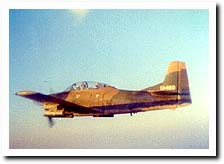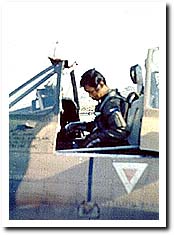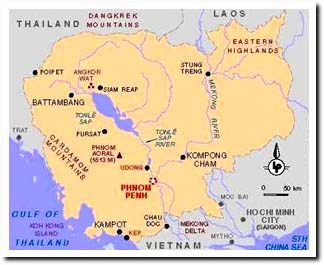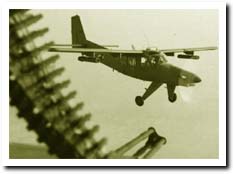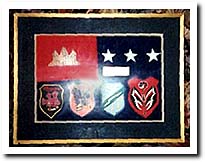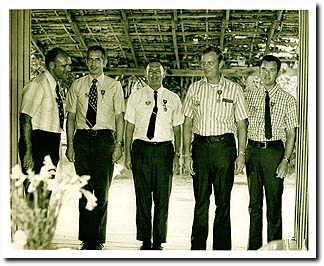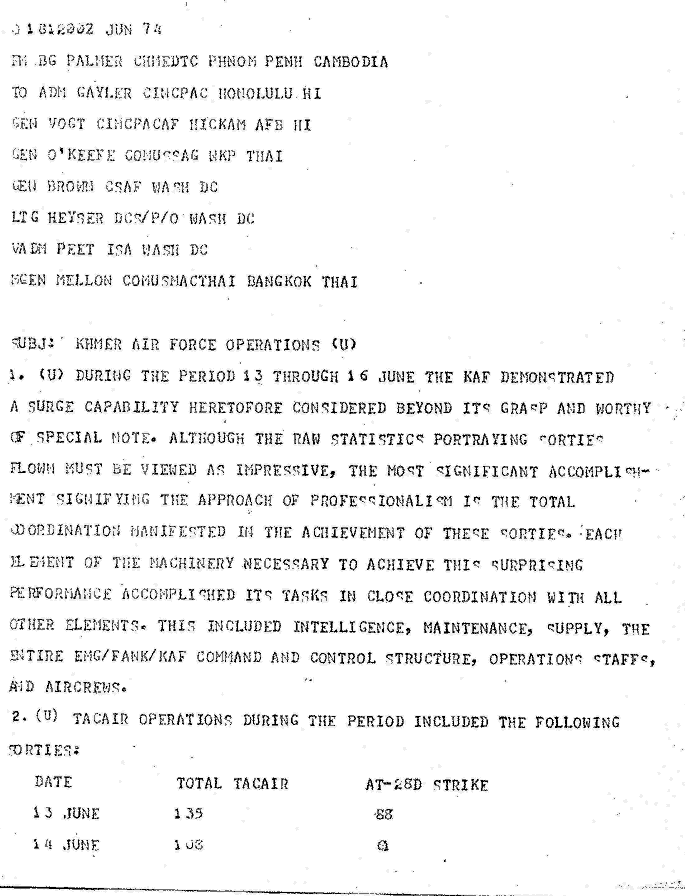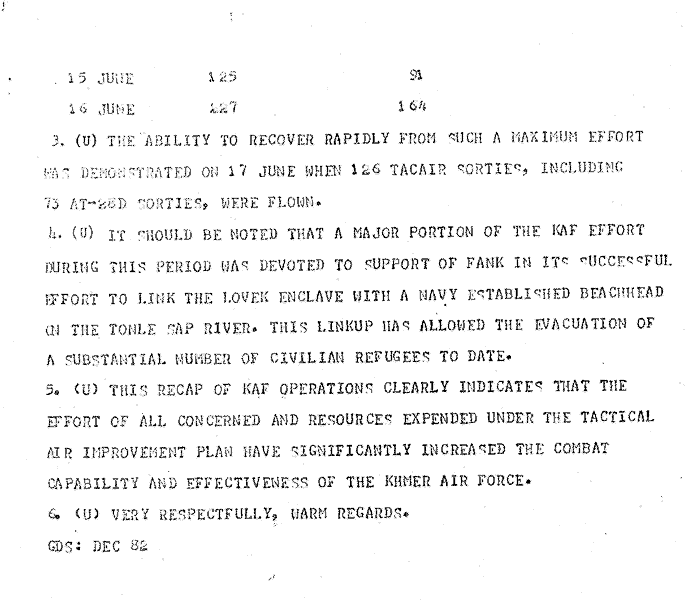"Glory is fleeting, but obscurity is forever. " - Napoleon Bonaparte My career in the Air Force received a giant boost around Christmas time 1972 when General Barnes the SOF commander called me into his office. He said, “I see by your records that you never finished your degree.” The general being an old personnel hand realized the importance of having this piece of paper and asked me if he could arrange a final semester TDY to Bootstrap would I go. I told him that I would check to see if I could find a college that would take me on short notice. I was in my final semester of Bootstrap finishing up my Bachelors Degree when I received word that I was alerted for another assignment to South East Asia (SEA). I had always marked the volunteer block for SEA on my assignment dream sheet and this time the Military Personnel Center acted upon it. I was to be the Executive Officer to Major General Jack Bellamy, the J-3 for USSAG / 7th AF. I was to report to Nakhon Phnom (NKP) in mid August 1973. This assignment made me doubly happy as I had come out on the last promotion list to Lt. Colonel. There was another pleasant surprise. I was to be reunited with my old friend Bob Downs who had already been at NKP for two or three months when I arrived. It seems that we can’t stay away from each other, sounds like the wild times at Luang Prabang all over again doesn’t it. Also, back at Hurlburt, we had spent a good deal of time flying together in the A-37 as pilots in the 603rd Air Commando Squadron commanded by Dick Secord. Being assigned to 7th AF at this time in 1973 was a non-event. We had halted the bombing and were in the process of disengaging from South Vietnam. Our POWs had been released and many people saw no reason for us to remain in SEA. Having a lot of sweat equity invested in what we were doing, I felt very strongly that there were a lot of reasons for us to continue supporting our friends. I was glad that we were still flying SKYSPOT and MSQ missions to help the Cambodians hang on until we could supply the means and material needed for them to defend themselves. A short time after I arrived at NKP, I joined Bob’s study group for the Industrial College of the Armed Forces correspondence course. We had a lot of time to devote to these type activities now that the war was winding down, and it gave us something to do in the evenings. I didn’t know at this time that there were moves underway that would soon put me right in the middle of the Cambodian conflict. It was also about this time the bad news arrived that General Ma had been killed leading another abortive coup against Vientiane. Shaking up Headquarters "A pessimist sees the difficulty in every opportunity; an optimist sees the opportunity in every difficulty." - Sir Winston Churchill One day in early December 1973, I was eating lunch in the Officer’s Club dining room when I looked up and saw Heinie come in. I had heard the generals at 7th AF talking about his recall to active duty in the grade of Brigadier General. Really blew their minds. I went over to say hi and Heinie told me that he wouldn’t have time to talk to me this trip, but that I would hear from him soon. It was about 10 days later that I was walking down the hallway past an empty office and the CAC phone was ringing on the desk, this was the secure phone that every office had and it never ever rang. How ironic is this, have the phone ringing in an office that is not mine and the phone call is for me. It was Heinie and all he said was “Don I can’t talk right now, I just wanted to alert you that we are bringing you on board for a special project, there should be a message in the read file in the morning”. I’m stunned. I go looking for Bob Downs and told him about the strange phone call. He hasn’t heard anything about any new project either but said, “it sure sounds like something Heinie would be involved in.” This whole situation seemed quite bizarre. Morning came and its a good thing that there were no windows in the USSAG / 7th AF headquarters building, because they may have been shattered by the loud vocal outbursts made by some very upset Generals. Who upon reading the morning read file in Blue Chip were asking me to explain this message from Hq USAF that stated I was a volunteer for a special project? I denied ever having seen this message, which was true. They had a few choice words about my going over their heads, which was not true. I explained about my chance meeting with General Aderholt on his visit to NKP, and the strange telephone call that I had received from him the day before. The discussion changed quickly as to why Heinie had been recalled and promoted over some officers that they felt more deserving. I assured them that I didn’t have any knowledge about his recall to active duty. Then the questions became more pointed in my direction. General Bellamy wanted to know what qualified me for this unique opportunity? I told them that I had some special operations experience with T-28s in Laos and that probably was why I was selected. Silently I thought, I didn’t really know, but suspected that Dick Secord had something to do with this whole situation and my being placed in this uncomfortable position. Meanwhile back to the generals. After some choice words like “I won’t stand for it”, and “we will never know what is going on down in Phnom Penh”, they took a softer approach. General O’Keefe, the 7th AF Commander, said to General Bellamy, that maybe it wouldn’t be a bad idea to have Moody in Phnom Penh. That way he could keep us informed as to everything that is going on. I thought to myself, “I don’t think so”. Both generals were adamant that when I got to Phnom Penh, I was to ensure that all messages going up the line were routed through NKP. Knowing the predicament this put me in, I thought to myself again, “I don’t think so”. I had a good idea that all of our internal message traffic between Phnom Penh and Bangkok back to Washington would be Back Channel. To Catch a Fly At last I got to see the mystery message which got the generals all excited, it stated that I was a volunteer for this special project that had “Very High Level of Interest and Emphasis”. Someone had to explain to me that the choice of these words meant Kissinger and Nixon. The message also relieved me from my assignment to 7th AF and assigned me to USMACTHAI for 179 days TDY. I had been assigned to Project Flycatcher. I found out that I would be working with Johnny Johnson, Larry Ropka, Jerry Klingaman, Ben Kraljev, John Mansur, Larry Harwood and Jim Cherry. Charlie Hicks was there to take care of our myriad personal needs and requirements. This was a Who’s Who in Special Operations and I was certainly proud to be a part of the team. The purpose of Flycatcher was to execute a plan to train and re-equip the Khmer Air Force with an upgraded TACAIR capability. It was called the “Tactical Air Improvement Plan Cambodia” (TAIPC). Larry with help from Johnny Johnson and Jerry Klingaman wrote it. Larry was on the Air Staff when the idea of TAIPC was first floated around. When it was time to formulate the study, he was loaned to the International Security Affairs Directorate in the Pentagon. Johnny and Jerry joined him there. His mentor in Washington, Eric Von Marbod, was very instrumental in getting the high level backing and funding necessary to get it approved. Our Team adopted Eric as our informal leader. The beauty of this plan is its simplicity. Problem was to get support out of CINCPAC, PACAF, and USSAG / 7th AF. Sounds familiar doesn’t it. Dream Team Our in-country team would be made up of Ben Kraljev the leader, John Mansur Larry Harwood Jim Cherry and myself. We were now officially Eric’s “Pistoleros”. What is strange are all the strings that had to be pulled to put this team together. Heinie and Jim Cherry were retired and had to be recalled to active duty. Ben was at the Royal War College in England and had to get an early dismissal. John Mansur was a student at AFIT, in the middle of finishing up his Masters in Aeronautical Engineering and had to get a special leave of absence. I have already told you of my mess at NKP.
It was simple, all we had to do was completely rebuild the Khmer Air Force and increase its effectiveness so as to offset the loss of U.S. TACAIR in Southeast Asia. We had a very challenging six months ahead of us to make the plan work. It was the same old scenario we faced in Laos. Every rainy season the good guys would kick the bad guys out of all their forward positions, and every dry season the bad guys would go on the offense and take it all back. Our team was now ready to go in-country as the dry season was just beginning and would continue until May or June when the wet season began. Welcome To Phnom Penh
We arrived at Pochentong Airport and were met by an Army guy, who was to pick us up and drive us into Phnom Penh. He would then take us to our quarters that had already been arranged for us. I noticed right away there was something ominous about the car he was driving. It was a black Chevrolet with armor plating in the doors and heavy bulletproof glass all the way round the car. I asked the silly question, “what is all this protection for”? He said that sometimes ambushes were set up to hit the embassy cars. That is why the cars were armored and they were careful as to the routes they would take. He said that they never used the same route two times in a row. I also noticed that there was no air conditioning. He said there was a State Department directive to disconnect the air from all the cars because of the 1973 oil embargo. The bulletproof glass made it impossible to lower the windows and this made for a very hot car. If the bad guys didn’t get you, heat stroke would. I remember Johnny’s parting words “you guys take care now”. On the way to our quarters, we stopped by the Embassy. Immediately apparent to me were the blast walls that sheltered both sides of all the walkways leading to the main building. Second silly question, “What are those blast fences supposed to protect you from”? He said that periodically the Embassy would be the target of the Russian 122mm rockets and captured 105mm Howitzers that the bad guys fired into the city. The contingency plan for a rocket or artillery attack, called for everyone to get into the Embassy stairwell. The blast walls were to protect you while you were running for cover. It was like the sand filled ammo cans I had in Laos, but on a larger scale. Later during a rocket attack, I ran smack over a big burly Embassy guy who was also running for the protection of the big building. When the shells started going off, you could count on everyone heading for the Embassy building. Our team soon grew tired of constantly stopping what we were doing and going to the stairwell; so we decided to take our chances and stay in our little office building. It worked for us. One afternoon Buzz Curry was heading out the front gate in his jeep when a 105mm round went off right in front of his vehicle and several large pieces of shrapnel came through his windshield. Maybe there was something to this thing of having bulletproof glass on the black Chevys. I could see that we were off to a good start on this project. All we had to do was survive ambushes, rockets, and artillery barrages. There was more to this. As I mentioned the bad guys had captured several batteries of 105 Howitzers. Everyday they would turn them loose on some part of the city. There were times when very large fires roared out of control at several spots in the city at the same time. Sometimes they burned for days, but I will touch on this again later. We arrived at our house; it was located behind the Department of Defense Building. I asked another stupid question, “doesn’t having our house next to that building make this a prime target”. Oh yes, your house took a rocket hit on that outside wall in September and they have just finished repairing it. Well whoop-de-do, they already had us zeroed in and all we had to do was wait. It would be like shooting fish in a barrel,
Every night while we were sitting on the roof, we would record on cassette tape our report to be sent to Bangkok. Every time we saw a rocket impact we would raise the mike to record the explosion so that Johnny, Larry and Jerry could hear what they had got us into. Some nights it took longer to make the report because of frequent interruptions. We were to share our house with two Army Colonels from MEDTC. Oh yes, this is the acronym for Military Equipment Delivery Team Cambodia, which was the major conduit for getting all the new stuff into Cambodia. All of the U.S. services were well represented as well as all of the functional areas. The Commander of MEDTC was Brigadier General Cleland, an Army General who joined the long list of other generals with his request to have all correspondence leaving Phnom Penh go through his office. This time I think that Ben thought to himself, “I don’t think so”. The two Army guys that we shared the house with were great. One was a helicopter pilot and the other was a Logistics type. We all hit it off right away. They were to provide us with invaluable information about the Khmer military. Out of curiosity we asked them about the rockets. They said most impacted in the city and not where we were located. They said that they were not in the house when the rocket hit. The rocket came in during the daytime while they were at the office. We may be in a safer place than we originally thought. What is the probability for lightning striking twice in the same spot? Ben, John, and myself had been assigned to the house with the Army guys. Larry was assigned to a house on the outskirts of town with Air Force guys. When I saw where Larry was going to be staying, I thought about how vulnerable we had been in LP on the outskirts of town. This house was much closer to the rocket launching points than where we were staying. Jim Cherry was staying in the house where all the maintenance types were quartered. I don’t know why, but everyone wanted to stay there. I guess it was because that’s where all the women liked to hang out. This house had a strange appearance. It looked like it was inside a giant monkey cage. The house was completely surrounded by a chain link fence enclosure that covered it on top and all four sides. Fourth stupid question, “why the chain link fencing”? The answer was, “the fencing would protect the house from attacks with RPGs “. It seems as though it was a frequent target of bad guys on motor scooters, that fired at it as they rode by. Nice thought to go to bed with every night. The more I thought about our new surroundings, I begin to think my questions hadn’t been stupid at all. Wanted - Joint Coordinated Effort The bad guys were engaged in Psychological Warfare with the populace of Phnom Penh. It was very apparent by the tactics they employed. The 122mm rockets and 105 Howitzers were used as terror weapons. Within weeks of our arrival in Phnom Penh, the bad guys began to randomly fire them throughout the city. They were also aimed at specific selected targets like the market place, where it was certain that there would be a lot of people. They also hit the refugee areas of town where there was always a lot of congestion. The explosions and fires would cause a lot of panic, which they did. The strategy was very effective as every aspect of life in the city was disrupted. The barrage sometimes lasted for hours. After months of daily barrages, the effect on the populace was beginning to show. The Khmer military had retreated into a number of enclaves along the Mekong, Tonle Sap, and other LOCs that they thought would be easier to defend. Doing this would also make it easier for the enclaves to be re-supplied by using the various waterways. This however, made every ship on the river a target for the bad guys. I’m talking about big ships, freighters and tankers in convoys. Protection of these convoys would require dedicated air support and a coordinated effort between the KAF (Air Force), MNK (Navy), and the FANK (army designation for “Forces Armee Nationale Khmer). It made cooperation a necessary if not a mandatory requirement to combat the tactics being used against the military and civilian populace. The bad guys were very good at setting up hidden ambushes along the Mekong and other routes into Phnom Penh and had been successful in hitting many of the big ships. It was getting so bad that there was talk of temporarily halting the convoys. This would have been devastating to Phnom Penh, as it would shut off food and POL supplies. This was another reason that it was mandatory to establish a Combined Operations Center (COC) with a DASC to coordinate the KAF air capabilities with the Army and Navy. It had been readily apparent for some time that some form of joint effort was needed by the Army and the KAF to respond to the incessant attacks on the city by the bad guys. In the past, the Defense Attaché had worked with the Khmer military and tried to get them to work together but had not been very successful. The Army didn’t trust the KAF. There had been recent defections by KAF pilots, who dropped their bombs on the palace on their way into exile. The palace was where General Lon Nol had his Headquarters. Now every time an airplane approached the palace, 37mm triple A would open up on the intruder no matter whether it was military or civilian. One day I looked up and here came this civilian C-46 with an engine out, prop feathered, heading by the most direct route back to Pochentong. His flight was going to take him in close proximity to the palace. Soon he had all the guns in the city firing at him. I don’t think they hit him, but they surely got his attention. For awhile, it got so bad that each strike flight had a T-28 riding shotgun armed with rockets with orders to shoot down any plane deviating from the flight plan. This was done to intimidate the KAF. In addition, the KAF were not allowed to load more than four bombs per aircraft. This really cut into what was already a limited TACAIR capability. This made it very plain that our first step had to be to re-instill trust between the KAF and the FANK. Tactical Air Control System All I had heard since my arrival was how every branch was independent and wanted to do their own thing. It was apparent; that what seemed to be missing in past attempts to conduct joint operations was some form of Centralized Control. I thought back to my AGOS days and what I remembered about Joint Operations and Centralized Control. Ben and I discussed it and decided that good Command and Control would require mandatory use of the “Combined Operations Center”. This would ensure that the joint components were available for use and all requests for TACAIR were reasonable. The FACs would need to be controlled by the Direct Air Support Center. This way their daily activities could be coordinated with using FANK or MNK units that had their targets already approved. The KAF Tactical Air (T-28s and AU-24s) could be ordered by FRAG to a FAC to use against a pre-determined target. The DASC would also be responsive to FACs flying Convoy Patrol or Visual Recce of direct routes or areas. This would require keeping some of the TACAIR resources on alert or in reserve for such a contingency. If a target was identified and reported to the DASC, then Alert assets could be launched to the requesting party.
Trying to satisfy every excuse for not flying more sorties was time consuming and we didn’t have a lot of time. We finally got them to load all six wing stations on the T-28. It became a question of mathematics. When we showed them that they could increase their efficiency by over 30% for a flight of three T-28s it finally started to make sense. In other words, it was the same as adding a fourth T-28 to each of their three ship flights by adding the additional six bombs. We elaborated further, that if you actually added that fourth T-28 with six bombs; you could increase efficiency by another 30%. Success The guys back in Bangkok agreed with our team assessment of the situation. We all strongly felt that to break out of our dilemma it would be necessary for the Khmer military to be successful in some major planned operations. We put in a request for targeting information through our troops in Bangkok to see if they could get some help from 7th AF targeting assets. They responded with some great opportunities and the KAF began to plan for a major air offensive. We wanted to maximize the KAF operation, and by working through the COC, we convinced the other Khmer military services into mounting some major dry season operations against the bad guys whom were now moving into defensive positions. Good things were starting to happen, but we were now running up against our June–July time frame for TAIPC to be successful. Heavy air strikes were planned for early June against some major supply points found by the Photo Interpreters at Udorn. The targets had tons of supplies and POL in drums in areas adjacent to the Tonle Sap River north of Kom Pong Luong. The targets were struck with great results with many secondary explosions and fires. The POL smoke rose in the area to 10,000 ft. The KAF were elated. The recce photos showed that the air strikes were 80% effective. All of the aircraft returned safely. It was easy to get the KAF to fly after these successes. They all wanted to fly missions where you could get good results and no battle damage. Everyone was happy around the office. John and Larry’s hard work had paid off, and they were high in their praise of the Khmer pilots. KAF went from flying an average of 1476 T-28 sorties in the months from January to May, to flying 2375 sorties in June. That is a 61% increase in efficiency and can be attributed solely to TAIPC. At about this same time, the COC came up with a plan for a major operation to relieve the pressure on Lovek with the FANK mounting an attack up Route 5 to recapture Kom Pong Luong. At the same time the MNK, under the cover of this operation, would make a determined effort to evacuate the civilian refugees from Lovek to Kom Pong Chhnang. The MNK (Khmer Navy) can be commended for the success of their operation and for the ability to establish effective security along the river. The KAF also received high marks for their sustained effort to provide effective air support that included a major surge effort on the days just before Kom Pong Luong was captured. This was a significant event because the COC and the Khmer military had learned to coordinate their actions between the various headquarters. We finally had the icebreaker for TAIPC. Ben and the guys back in Bangkok could finally take a breather and relax. The KAF had a newfound pride in themselves. From this day on the KAF were able to sustain the maximum daily sortie rate for all of their TACAIR assets. It was unbelievable the way our program went from the outhouse to the penthouse with one operation. The FANK also found out that the KAF could indeed help them and that much could be gained by cooperating. The team was lucky to have Ben Kraljev as the leader. He had the perfect personality for working out solutions to overcome the roadblocks placed in our path by the Embassy and MEDTC. He was able to keep the rest of the team focused and not be bothered by naysayers. Me, I had never been associated with a project where I wasn’t expected to fly. I found that this was a lot harder than flying combat, and I had a lot more respect for all the hard work that is required in bringing a good plan to a satisfactory conclusion. Recognition for a Gallant Effort "All truth passes through three stages. First, it is ridiculed. Second, it is violently opposed. Third, it is accepted as being self-evident." - Arthur Schopenhauer
We had been allowed six months to execute the plan and it took almost exactly six months to finally show any improvement in KAF capabilities. We were never able to determine, was our success a result of good planning or good luck. The DASC and centralized control through the COC had worked and provided the means to support the big combined operations. There were many watchers on the sideline that were not necessarily supporters of our efforts and it must have really hurt to have to write some of the positive things that were included in the message traffic. Of course the message traffic was generated following our declaration of victory and addressed to the world.
The Following message summaries attest to our success: 1. ADM Gayler CINCPAC to BGEN Palmer CHMEDTC – Pleased to note part played by greatly improved Khmer Air Force in successes during current dry season. Now clear that Tactical Air Improvement Plan was sound. Appreciate your efforts and the support of your staff in making plan work. Well Done 2. LGEN Huyser HQ USAF to USMACTHAI wrote – Pleased to learn of KAF TACAIR successes. Especially gratified by indications of maturing coordination between the various military headquarters. We add a hearty “Well Done” to all concerned. 3. ADM Gayler CINPAC wrote to Commander Khmer Air Force – I note with pleasure the outstanding professional performance by KAF on 16 June. Request you convey my personal congratulations on a great job. Keep up the good work. 4. MGEN Bellamy USSAG/7th AF wrote to Commander Khmer Air Force – KAF’s consistently effective support of both FANK and MNK operations, and their demonstrated surge capability during periods of intense combat activity reflect the will and fighting spirit of the Khmer Armed Forces. Please accept, on behalf of GEN O’Keefe, our congratulations and admiration for these major accomplishments. Best wishes for continued success. Ben and the rest of our team could now go home and finish those things that were put on hold when we were assigned to this project, but Johnny, Larry and Jerry were committed to remain in Bangkok until the bitter end. Heinie could take satisfaction in knowing that everyone involved in this project from start to finish gave everything they had to give. My Generals at NKP forgave me for jumping ship and took a lot of the credit for the success of our project because of their wisdom in letting me go to Phnom Penh. It took awhile for me to get use to the absence of noise but I found out that silence is even worse. I was also hesitant to answer any telephones for awhile especially if I knew Heinie or Dick Secord was around, but all in all I was damn proud of what we accomplished. I have only related some of the more interesting activities about my experiences in Laos and Cambodia. There are many more equally as important. I am sorry that it has taken so long to finally tell these stories. I guess one of the main reasons is that the Air Commandos I most admire are naturally closed-mouth about the classified projects that they have been involved in. My motivation for finally writing these stories is that I didn’t want to die or get so old that I couldn’t remember them anymore. I felt that I owed it to my friends and family to put a story behind the many pictures that I have collected over my years in Special Operations.
|

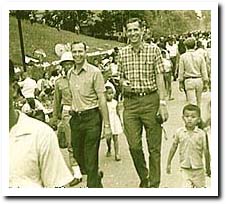
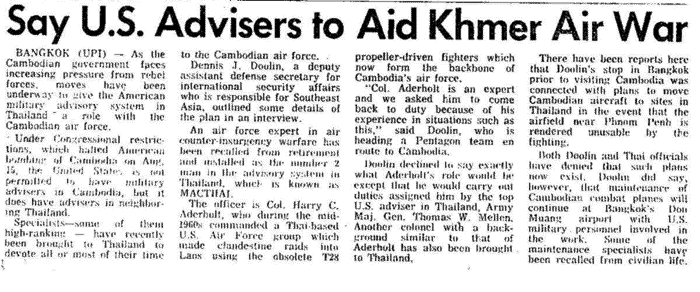
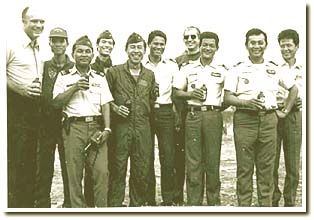 Ben Kraljev and Don Moody with KAF T-28 pilots
Ben Kraljev and Don Moody with KAF T-28 pilots
